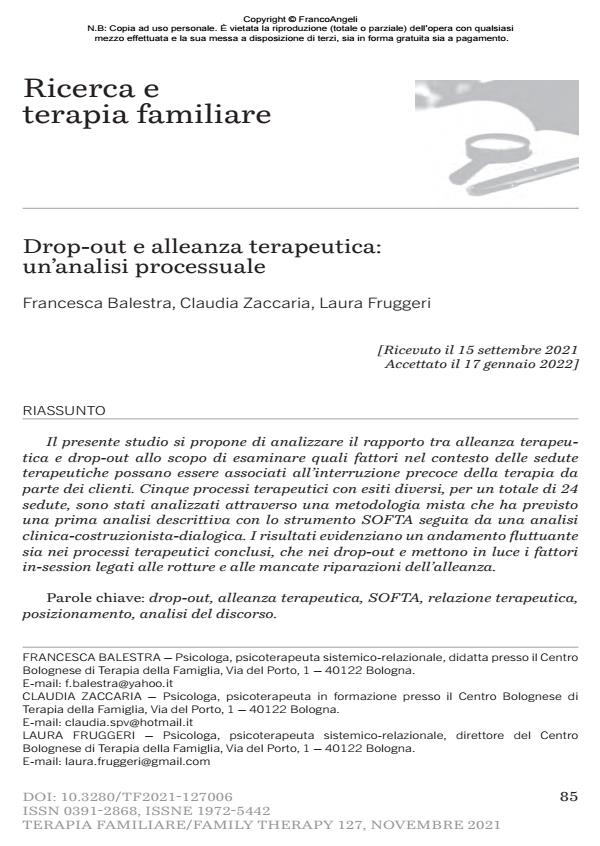Drop-out e alleanza terapeutica: un’analisi processuale
Titolo Rivista TERAPIA FAMILIARE
Autori/Curatori Francesca Balestra, Claudia Zaccaria, Laura Fruggeri
Anno di pubblicazione 2022 Fascicolo 2021/127
Lingua Italiano Numero pagine 22 P. 85-106 Dimensione file 672 KB
DOI 10.3280/TF2021-127006
Il DOI è il codice a barre della proprietà intellettuale: per saperne di più
clicca qui
Qui sotto puoi vedere in anteprima la prima pagina di questo articolo.
Se questo articolo ti interessa, lo puoi acquistare (e scaricare in formato pdf) seguendo le facili indicazioni per acquistare il download credit. Acquista Download Credits per scaricare questo Articolo in formato PDF

FrancoAngeli è membro della Publishers International Linking Association, Inc (PILA)associazione indipendente e non profit per facilitare (attraverso i servizi tecnologici implementati da CrossRef.org) l’accesso degli studiosi ai contenuti digitali nelle pubblicazioni professionali e scientifiche
Il presente studio si propone di analizzare il rapporto tra alleanza terapeutica e drop-out allo scopo di esaminare quali fattori nel contesto delle sedute terapeutiche possano essere associati all’interruzione precoce della terapia da parte dei clienti. Cinque processi terapeutici con esiti diversi, per un totale di 24 sedute, sono stati analizzati attraverso una metodologia mista che ha previsto una prima analisi descrittiva con lo strumento SOFTA seguita da una analisi clinica-costruzionista-dialogica. I risultati evidenziano un andamento fluttuante sia nei processi terapeutici conclusi, che nei drop-out e mettono in luce i fattori in-session legati alle rotture e alle mancate riparazioni dell’alleanza.
Parole chiave:Drop-out, alleanza terapeutica, SOFTA, relazione terapeutica, posizionamento, analisi del discorso.
- Aronsson K. & Cederborg A.C. (1994). Co-narration and voice in family therapy. Voicing, devoicing, and orchestration. Text, 14: 345-370. DOI: 10.1515/text.1.1994.14.3.345
- Bartle-Haring S., Glebova T., Gangamma R., Grafsky E. & Delaney R.O. (2012). Alliance and termination status in couple therapy: A comparison of methods for assessing discrepancies. Psychotherapy Research, 22(5): 502-514. DOI: 10.1080/10503307.2012.676985
- Beck M., Friedlander M.L. & Escudero V. (2006). Three perspectives on clients’ experiences of the therapeutic alliance: A discovery-oriented investigation. Journal of Marital and Family Therapy, 32(3): 355-368. DOI: 0.1111/j.1752-0606.2006.tb01612.x
- Escudero V., Boogmans E., Loots G. & Friedlander M.L. (2012). Alliance rupture and repair in conjoint family therapy: An exploratory study. Psychotherapy, 49(1): 26-37. DOI: 10.1037/a0026747
- Eubanks C.F., Muran J.C. & Safran J.D. (2018). Alliance rupture repair: A etaanalysis. Psychotherapy, 55(4): 508-519. DOI: 10.1037/pst0000185
- Friedlander M.L., Escudero V. & Heatherington L. (2006). Therapeutic alliances in couple and family therapy: an empirically informed guide to practice. Washington: American Psychological Association (trad. it.: Alleanze Terapeutiche nella terapia di coppia e della famiglia. Roma: Firera & Liuzzo, 2010).
- Fruggeri L., Balestra F. & Venturelli E. (2020). Le competenze psicoterapeutiche. Bologna: il Mulino.
- Harré R., Moghaddam F.M., Pilkerton Cairnie T., Rothbart D. & Sabat S.R. (2009). Recent advances in positioning theory. Theory and Psychology, 19: 5-31. DOI: 10.1177/0959354308101417
- Horvath A.O. & Bedi R.P. (2002). The alliance. In: Norcross J.C., a cura di, Psychotherapy relationships that work. New York: Oxford University Press.
- Johnson L.N., Wright D.W. & Ketring S.A. (2002). The therapeutic alliance in homebased family therapy: is it predictive of outcome? Journal of Marital and Family Therapy, 28: 93-102. DOI: 10.1111/j.1752-0606.2002.tb01177.x
- Jones E. (2003). Working with the “Self ” of the therapist in consultation. Human Systems, 14(1): 7-16.
- Kivlighan D.M. Jr. & Shaughnessy P. (2000). Patterns of working alliance development: A typology of client’s working alliance ratings. Journal of Counseling Psychology, 47(3): 362-371. DOI: 10.1037/0022-0167.47.3.362
- Knobloch-Fedders L.M., Pinsof W.M. & Mann B.J. (2007). Therapeutic alliance and treatment progress in couple psychotherapy. Journal of Marital and Family Therapy, 33: 245-257. DOI: 10.1111/j.1752-0606.2007.00019.x
- Kreppner K. (2009). Analizzare le “strutture profonde” dei processi familiari. In: Fruggeri L., a cura di, Osservare le famiglie. Roma: Carocci.
- Martin D.J., Garske J.P. & Davis M.K. (2000). Relation of therapeutic alliance with outcome and other variables: a meta-analytic review. Journal of Consulting and Clinical Psychology, 68: 438-450. DOI: 10.1037/0022-006X.68.3.438
- Masi M.V., Miller R.B. & Olson M.M. (2003). Differences in dropout rates among individual, couple and family therapy clients. Contemporary Family Therapy, 25(1): 63-75. DOI: 10.1023/A:1022558021512
- Muñiz de la Peña C., Friedlander M. & Escudero V. (2009). Frequency, severity and evolution of split family alliances: How observable are they? Psychotherapy Research, 19(2): 133-142. DOI: 10.1080/10503300802460050
- Ochs E. & Taylor C. (1996). The “father knows best” dynamic in dinnertime narratives. In: Hall K., a cura di, Gender articulated: language and the socially constructed Self. London: Routledge.
- Robbins M.S., Liddle H.A., Turner C.W., Dakof G.A., Alexander J.F. & Kogan S.M. (2006). Adolescent and parent therapeutic alliances as predictors of dropout in multidimensional family therapy. Journal of Family Psychology, 20(1): 108-116. DOI: 10.1037/0893-3200.20.1.108
- Robbins M.S., Turner C.W., Alexander J.F. & Perez G.A. (2003). Alliance and dropout in family therapy for adolescents with behavior problems: Individual and systemic effects. Journal of Family Psychology, 17(4): 534-544. DOI: 10.1037/0893-3200.17.4.534
- Stiles W.B., Glick M.J., Osatuke K., Hardy G.E., Shapiro D.A., Agnew-Davies R., Rees A. & Barkham M. (2004). Patterns of Alliance Development and the Rupture-Repair Hypothesis: Are Productive Relationships U-Shaped or V-Shaped? Journal of Counseling Psychology, 51(1): 81-92. DOI: 10.1037/0022-0167.51.1.81
- Tannen D. (2007). You just don’t understand. Women and men in conversation. New York: Harper & Collins.
- Yoo H., Bartle-Haring S. & Gangamma R. (2016). Predicting premature termination with alliance at sessions 1 and 3: An exploratory study. Journal of Family Therapy, 38: 5-17. DOI: 10.1111/1467-6427.12031
Francesca Balestra, Claudia Zaccaria, Laura Fruggeri, Drop-out e alleanza terapeutica: un’analisi processuale in "TERAPIA FAMILIARE" 127/2021, pp 85-106, DOI: 10.3280/TF2021-127006